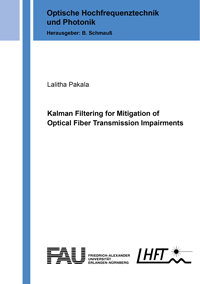
Shop : Details
Shop
Details
45,80 €ISBN 978-3-8440-6662-3Softcover138 pages78 figures203 g21 x 14,8 cmEnglishThesis
May 2019
Lalitha Pakala
Kalman Filtering for Mitigation of Optical Fiber Transmission Impairments
In this thesis, the potential of Kalman filtering is exploited for the joint mitigation of several optical transmission impairments including laser phase noise, fiber nonlinearity, amplitude noise, frequency offset as well as polarization effects. A carrier phase and amplitude noise estimation (CPANE) algorithm is proposed and implemented using an extended Kalman filter (EKF) that estimates a complex quantity to track the phase and amplitude noise, simultaneously. Although, various DSP algorithms have been studied in this thesis, more emphasis will be given to the EKF-CPANE algorithm. Its performance is investigated in detail and compared to the conventional DSP algorithms. Approaches to enhance the nonlinear tolerance of the EKF-CPANE algorithm by incorporating with the existing techniques like digital backward propagation (DBP) will be presented. A two stage EKF approach is introduced that exhibits an improved tolerance towards phase and frequency offsets. Furthermore, an adaptive and cascaded Kalman filtering (CKF) is proposed for the joint tracking of polarization state and phase noise. A brief analysis on incorporating forward error correction (FEC) with the EKF-CPANE algorithm is also discussed. Extensive numerical investigations prove that the Kalman filters offer an attractive solution to jointly compensate several optical transmission impairments and thereby, enhance the transmission performance. Moreover, owing to their real-time feasibility and low complexity, Kalman filters seem to be a promising component of future coherent receivers.
Keywords: Kalman filter; QAM; Coherent optical communication; Digital Signal Processing; Carrier phase estimation; Nonlinear Mitigation; Phase noise; ASE noise; extended Kalman filter; Coherent recievers; Frequency offset; Polarization de-multiplexing
Optische Hochfrequenztechnik und Photonik
Edited by Prof. Dr.-Ing. Bernhard Schmauß, Erlangen-Nürnberg
Available online documents for this title
You need Adobe Reader, to view these files. Here you will find a little help and information for downloading the PDF files.
Please note that the online documents cannot be printed or edited.
Please also see further information at: Help and Information.
Please also see further information at: Help and Information.
| Document |  | Document | ||
| Type |  | |||
| Costs |  | 34,35 € | ||
| Action |  | Purchase in obligation and download the file | ||
| Document |  | Table of contents | ||
| Type |  | |||
| Costs |  | free | ||
| Action |  | Download the file | ||
User settings for registered online customers (online documents)
You can change your address details here and access documents you have already ordered.
User
Not logged in
Export of bibliographic data
Shaker Verlag GmbH
Am Langen Graben 15a
52353 Düren
Germany
Am Langen Graben 15a
52353 Düren
Germany
Mon. - Thurs. 8:00 a.m. to 4:00 p.m.
Fri. 8:00 a.m. to 3:00 p.m.
Fri. 8:00 a.m. to 3:00 p.m.
Contact us. We will be happy to help you.



